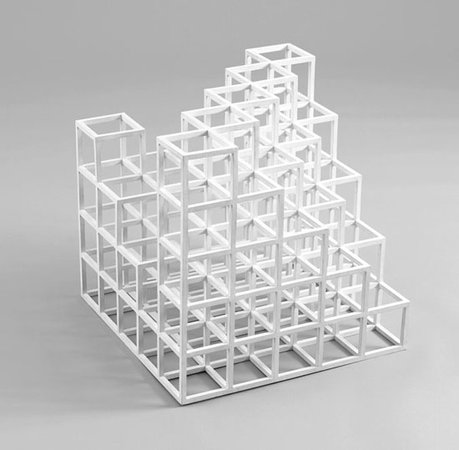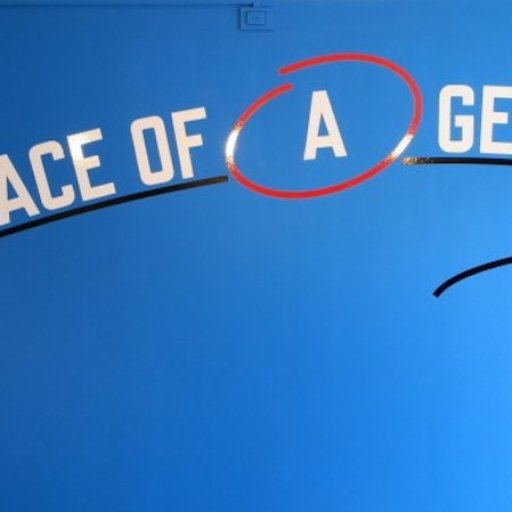No one could blame you for expecting conceptual art to be cold, impenetrable, and impassive; nor for noticing that the genesis of conceptualism, which pared the artwork down to its most basic forms, only shortly preceded the general explosion of the art market in the West. Rising prices, ironically, seem to have coincided with diminishing forms. One could be forgiven for feeling somewhat cynical about this fact. But Sol LeWitt's work is a buooyant reminder of the way that apparent simplicity often shrouds the real work of the conceptual work of art—the work done within the artist's mind; the labor of conception, translated through an artist's programmatic treatment into simple lines, colors, and shapes.
For work that are so easy to tangle up in seeming impenetrable cerebrations, LeWitt's wall drawings, sculptures, paintings, and writings are all surprisingly immediate and graspable. You just have to know what you're looking at. Here's our primer for the artist's intellectually stimulating output.
SENTENCES, PARAGRAPHS, AND INSTRUCTIONS
The key to grasping LeWitt's oeuvre is to understand that the written word is a central part of his artistic experimentation. His text "Paragraphs on Conceptual Art," which was published inArtforum in 1967, is widely considered a milestone text in transition from the Minimalism of the '60s to the Conceptual Art of the '70s. LeWitt's text is presented in the format of a manifesto in 17 paragraphs, each of which concerns an imperative statements and definitive answers to questions that audiences had about the art of the moment. (A sample: "It doesn’t really matter if the viewer understands the concepts of the artist by seeing the art. Once it is out of his hand the artist has no control over the way a viewer will perceive the work. Different people will understand the same thing in a different way.")
This initial text was followed by "Sentences on Conceptual Art" two years later, in 1969, which was published in0 to 9magazine in New York and Art-Language in England. Paring down his own logical derivations from paragraphs to sentences, LeWitt charted the course for his work to come. The document distances LeWitt's idea of conceptual art from both rationality ("1. Conceptual artists are mystics rather than rationalists. They leap to conclusions that logic cannot reach") and freewheeling anarchy ("32. Banal ideas cannot be rescued by beautiful execution"), placing equal weight on the importance of lyrical expression and on artists' freedom to follow their intuition and experiment with ideas.
PERMUTATIONS
Following his own maxims, LeWitt produced whole series of works based on the simple permutation of a given number of variables within an arrangement of a certain size; for example, in 1974's Incomplete Open Cubes, which charts 123 variations of the depiction of an open cube through simple geometry. For many of his sculptures, LeWitt provided his assistants or professional fabricators with a set of instructions that they were then responsible for carrying out—but these instructions purposefully include elements that are open to interpretation, so that the fabricator of the work must, by necessity, engage the element of chance, resulting in works that are never consistently exactly the same. This open-endedness shows that LeWitt celebrates the interplay of determined structures and the fluctuations of chance.
With titles like 1992's One-Two-One With Two Half-Off, LeWitt's "stack" sculptures curtail aesthetic spectacle in favor of laying bare the relationship between the way the viewer experiences the artwork and the idea in the artist's mind. These titles serve as basic 'scores' for the concept of the work. Think of the sculpture as a cartoon, and the title as a caption: without one, you can't understand the other, and the whole work is only revealed in the play between them.
WALL DRAWINGS
Perhaps LeWitt's most well known work is the series of wall drawings he produced between 1968 and his death in 2007. Existing as a set of instructions, these works are to be drawn directly onto the wall of whatever room they're exhibited in; in theory, anyone can carry out the instructions and make their very own copy of the piece. (Of course, the 'official' versions are authenticated and must be prepared by a specially trained team dispatched by LeWitt's estate, but that won't stop you from putting one above your couch, if you so please—and if you have the patience.)
Like his stack pieces, LeWitt's wall drawings take the idea of producing an artwork from a set of instructions and derive beauty from their execution, inflected by the small decisions made by whomever is carrying them out. Unlike the work of minimalist artists like Donald Judd, who embraced industrial materials and fabrication techniques, LeWitt's wall works are ephemeral, and, when a temporary exhibition of them ends, the walls they're placed onto are simply painted over or demolished. It was an idea that came decades before the term "installation art" became popularly used, which is in part why the wall drawings have enjoyed such lasting and timeless power—so much so that the Massachusetts Museum of Contemporary Art's ongoing retrospective of LeWitt's wall drawings, which opened in 2008, will last all the way through 2033.



























